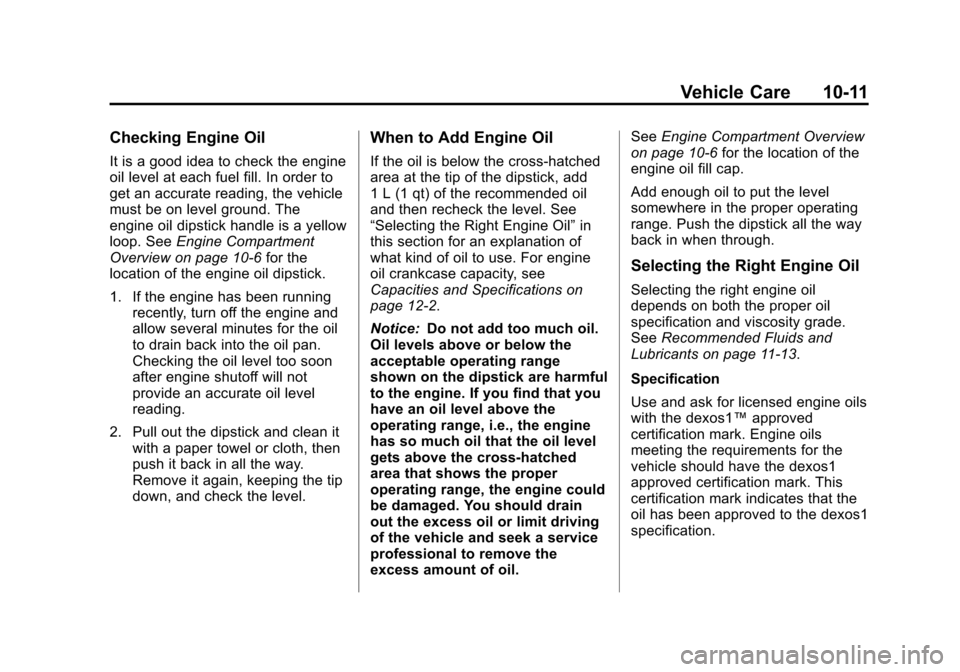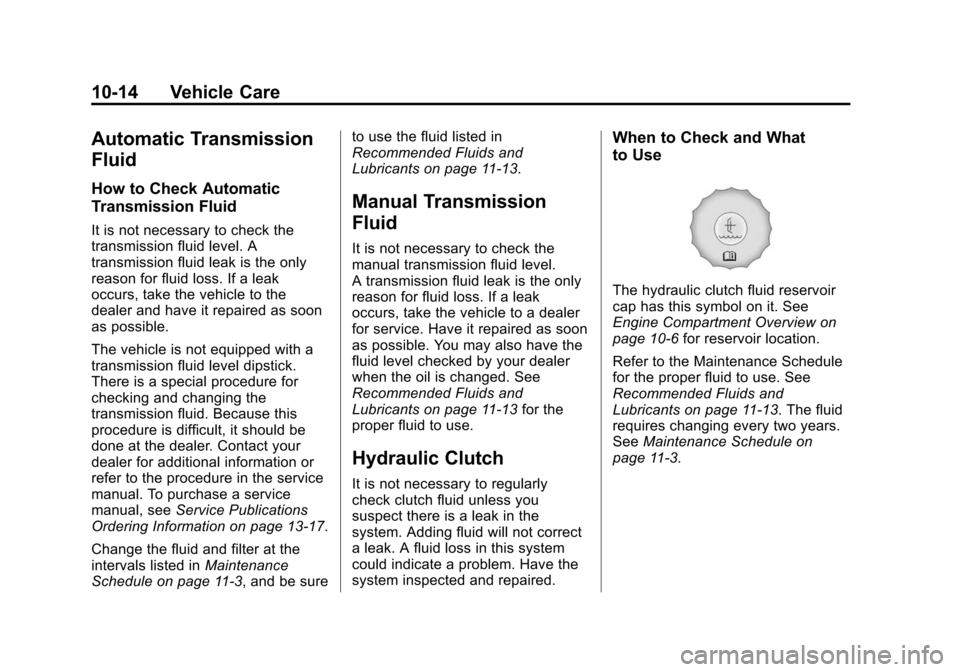oil dipstick CADILLAC CTS 2012 2.G Owners Manual
[x] Cancel search | Manufacturer: CADILLAC, Model Year: 2012, Model line: CTS, Model: CADILLAC CTS 2012 2.GPages: 496, PDF Size: 6.36 MB
Page 256 of 496

Black plate (6,1)Cadillac CTS/CTS-V Owner Manual (Include Mex) - 2012
9-6 Driving and Operating
If the vehicle starts to slide, follow
these suggestions:
.Ease your foot off the
accelerator pedal and quickly
steer the way you want the
vehicle to go. The vehicle may
straighten out. Be ready for a
second skid if it occurs.
.Slow down and adjust your
driving according to weather
conditions. Stopping distance
can be longer and vehicle
control can be affected when
traction is reduced by water,
snow, ice, gravel, or other
material on the road. Learn to
recognize warning clues—such
as enough water, ice, or packed
snow on the road to make a
mirrored surface —and slow
down when you have any doubt.
.Try to avoid sudden steering,
acceleration, or braking,
including reducing vehicle speed
by shifting to a lower gear. Any
sudden changes could cause
the tires to slide. Remember: Antilock brakes help
avoid only the braking skid.
Competitive Driving
Competitive driving may affect the
vehicle warranty. See the warranty
book before using the vehicle for
competitive driving.
Notice:
If you use your vehicle
for competitive driving, the
engine may use more oil than it
would with normal use. Low oil
levels can damage the engine. Be
sure to check the oil level often
during competitive driving and
keep the level at or near the
upper mark that shows the proper
operating range on the engine oil
dipstick. For information on how
to add oil, see Engine Oil on
page 10‑10.
CTS‐V Only: Be sure to check the
oil level often during racing, track
testing or other competitive driving
and keep the level at or near the upper mark that shows the proper
operating range on the engine oil
dipstick.
For competitive driving, it is
recommended that the brake fluid
be replaced with a high performance
brake fluid that has a dry boiling
point greater than 279°C (534°F).
After conversion to the high
performance brake fluid,
follow the brake fluid service
recommendations outlined by the
fluid manufacturer. Do not use
silicone or DOT‐5 brake fluids.
HF V6 Engine Only: Be sure to
check the oil level often during
racing, track testing or other
competitive driving and keep the
level at or near 0.5 L (0.5 qt) above
the upper mark that shows the
proper operating range on the
engine oil dipstick. For racing, track
testing or other competitive driving
an engine oil cooler must be
installed.
Page 319 of 496

Black plate (7,1)Cadillac CTS/CTS-V Owner Manual (Include Mex) - 2012
Vehicle Care 10-7
A. Windshield Washer FluidReservoir. See Washer Fluid on
page 10‑25.
B. Engine Compartment Fuse
Block (CTS Coupe and Sedan)
on page 10‑40 orEngine
Compartment Fuse Block
(CTS V Coupe and Sedan) on
page 10‑44 orEngine
Compartment Fuse Block
(CTS Wagon) on page 10‑47 or
Engine Compartment Fuse
Block (CTS V Wagon) on
page 10‑51.
C. Remote Positive (+) Terminal. See Jump Starting on
page 10‑104. D. Remote Negative (−) Terminal.
See Jump Starting on
page 10‑104.
E. Passenger Compartment Air Filter. See Passenger
Compartment Air Filter on
page 8‑6.
F. Engine Cooling Fan (Out of View). See Cooling System on
page 10‑18.
G. Power Steering Fluid Reservoir. See Power Steering Fluid on
page 10‑24.
H. Engine Oil Fill Cap. See Engine
Oil on page 10‑10. I. Engine Oil Dipstick (Out of
View). See Engine Oil on
page 10‑10.
J. Hydraulic Clutch Reservoir (If Equipped) (Not Shown). See
Hydraulic Clutch on page 10‑14.
K. Brake Master Cylinder Reservoir (Out of View).
See Brakes on page 10‑26.
L. Engine Coolant Surge Tank and Pressure Cap. See Engine
Coolant on page 10‑18.
M. Engine Air Cleaner/Filter on
page 10‑15.
Page 321 of 496

Black plate (9,1)Cadillac CTS/CTS-V Owner Manual (Include Mex) - 2012
Vehicle Care 10-9
A. Windshield Washer FluidReservoir. See Washer Fluid on
page 10‑25.
B. Engine Compartment Fuse
Block (CTS Coupe and Sedan)
on page 10‑40 orEngine
Compartment Fuse Block
(CTS V Coupe and Sedan) on
page 10‑44 orEngine
Compartment Fuse Block
(CTS Wagon) on page 10‑47 or
Engine Compartment Fuse
Block (CTS V Wagon) on
page 10‑51.
C. Remote Positive (+) Terminal. See Jump Starting on
page 10‑104.
D. Remote Negative (−) Terminal. See Jump Starting on
page 10‑104.
E. Engine Oil Fill Cap (Out of View). See Engine Oil on
page 10‑10.
F. Engine Oil Dipstick. See Engine
Oil on page 10‑10. G. Passenger Compartment Air
Filter. See Passenger
Compartment Air Filter on
page 8‑6.
H. Intercooler System Pressure Cap. See Cooling System on
page 10‑18.
I. Engine Cooling Fans (Out of View). See Cooling System on
page 10‑18.
J. Hydraulic Clutch Reservoir (If Equipped) (Not Shown). See
Hydraulic Clutch on page 10‑14.
K. Brake Master Cylinder Reservoir. See Brakes on
page 10‑26.
L. Engine Coolant Surge Tank and Pressure Cap. See Engine
Coolant on page 10‑18.
M. Power Steering Fluid Reservoir (Under Engine Cover). See
Power Steering Fluid on
page 10‑24.
N. Engine Air Cleaner/Filter on
page 10‑15.Engine Cover
Engine Cover (CTS)
To remove:
1. Remove the oil fill cap (A).
2. Raise the right front corner of
the engine cover (B) to release it
from the ball stud.
3. Pull the engine cover (B) forward to slide the rear tabs (C) out from
under the retainers.
Page 323 of 496

Black plate (11,1)Cadillac CTS/CTS-V Owner Manual (Include Mex) - 2012
Vehicle Care 10-11
Checking Engine Oil
It is a good idea to check the engine
oil level at each fuel fill. In order to
get an accurate reading, the vehicle
must be on level ground. The
engine oil dipstick handle is a yellow
loop. SeeEngine Compartment
Overview on page 10‑6 for the
location of the engine oil dipstick.
1. If the engine has been running recently, turn off the engine and
allow several minutes for the oil
to drain back into the oil pan.
Checking the oil level too soon
after engine shutoff will not
provide an accurate oil level
reading.
2. Pull out the dipstick and clean it with a paper towel or cloth, then
push it back in all the way.
Remove it again, keeping the tip
down, and check the level.
When to Add Engine Oil
If the oil is below the cross-hatched
area at the tip of the dipstick, add
1 L (1 qt) of the recommended oil
and then recheck the level. See
“Selecting the Right Engine Oil” in
this section for an explanation of
what kind of oil to use. For engine
oil crankcase capacity, see
Capacities and Specifications on
page 12‑2.
Notice: Do not add too much oil.
Oil levels above or below the
acceptable operating range
shown on the dipstick are harmful
to the engine. If you find that you
have an oil level above the
operating range, i.e., the engine
has so much oil that the oil level
gets above the cross-hatched
area that shows the proper
operating range, the engine could
be damaged. You should drain
out the excess oil or limit driving
of the vehicle and seek a service
professional to remove the
excess amount of oil. See
Engine Compartment Overview
on page 10‑6 for the location of the
engine oil fill cap.
Add enough oil to put the level
somewhere in the proper operating
range. Push the dipstick all the way
back in when through.
Selecting the Right Engine Oil
Selecting the right engine oil
depends on both the proper oil
specification and viscosity grade.
See Recommended Fluids and
Lubricants on page 11‑13.
Specification
Use and ask for licensed engine oils
with the dexos1™ approved
certification mark. Engine oils
meeting the requirements for the
vehicle should have the dexos1
approved certification mark. This
certification mark indicates that the
oil has been approved to the dexos1
specification.
Page 326 of 496

Black plate (14,1)Cadillac CTS/CTS-V Owner Manual (Include Mex) - 2012
10-14 Vehicle Care
Automatic Transmission
Fluid
How to Check Automatic
Transmission Fluid
It is not necessary to check the
transmission fluid level. A
transmission fluid leak is the only
reason for fluid loss. If a leak
occurs, take the vehicle to the
dealer and have it repaired as soon
as possible.
The vehicle is not equipped with a
transmission fluid level dipstick.
There is a special procedure for
checking and changing the
transmission fluid. Because this
procedure is difficult, it should be
done at the dealer. Contact your
dealer for additional information or
refer to the procedure in the service
manual. To purchase a service
manual, seeService Publications
Ordering Information on page 13‑17.
Change the fluid and filter at the
intervals listed in Maintenance
Schedule on page 11‑3, and be sure to use the fluid listed in
Recommended Fluids and
Lubricants on page 11‑13.
Manual Transmission
Fluid
It is not necessary to check the
manual transmission fluid level.
A transmission fluid leak is the only
reason for fluid loss. If a leak
occurs, take the vehicle to a dealer
for service. Have it repaired as soon
as possible. You may also have the
fluid level checked by your dealer
when the oil is changed. See
Recommended Fluids and
Lubricants on page 11‑13
for the
proper fluid to use.
Hydraulic Clutch
It is not necessary to regularly
check clutch fluid unless you
suspect there is a leak in the
system. Adding fluid will not correct
a leak. A fluid loss in this system
could indicate a problem. Have the
system inspected and repaired.
When to Check and What
to Use
The hydraulic clutch fluid reservoir
cap has this symbol on it. See
Engine Compartment Overview on
page 10‑6 for reservoir location.
Refer to the Maintenance Schedule
for the proper fluid to use. See
Recommended Fluids and
Lubricants on page 11‑13. The fluid
requires changing every two years.
See Maintenance Schedule on
page 11‑3.